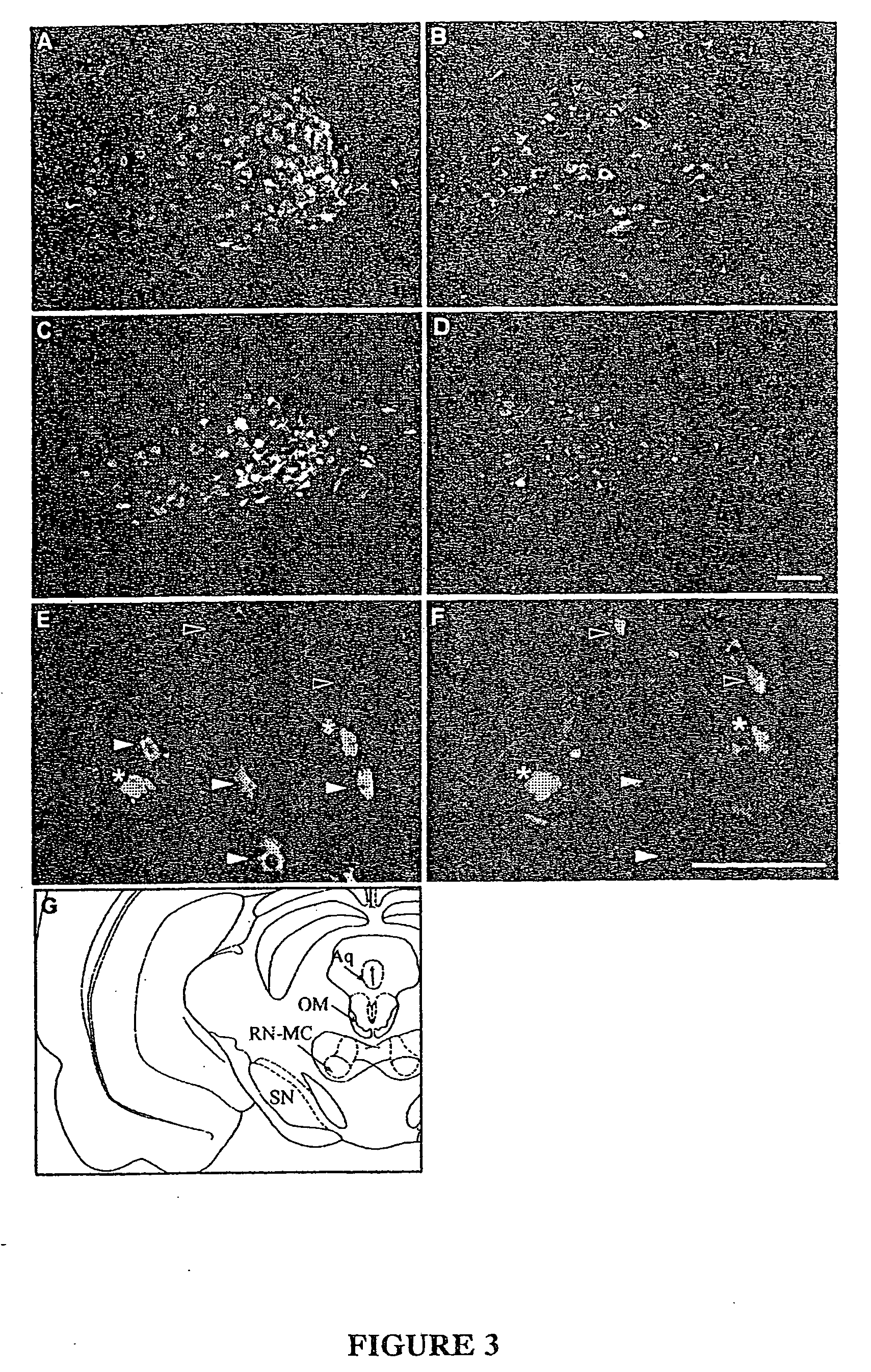Composition for neuronal regeneration comprising myelin-specific antibodies and complement proteins
a technology of myelin-specific antibodies and complement proteins, which is applied in the direction of antibody medical ingredients, peptide/protein ingredients, metabolic disorders, etc., can solve the problems of incomplete cns axonal disruption, permanent loss of voluntary movement below the site, and high risk of recovery from complete cns axonal disruption, etc., to promote regrowth, repair, and regeneration of neurons
- Summary
- Abstract
- Description
- Claims
- Application Information
AI Technical Summary
Benefits of technology
Problems solved by technology
Method used
Image
Examples
example i
Regeneration of Brainstem-Spinal Axons
[0203] The following example illustrates that the transient developmental suppression of myelination or the disruption of mature myelin by local intraspinal infusion of serum complement proteins along with a complement-fixing, myelin-specific antibody facilitates brainstem-spinal axonal regeneration after spinal transection in a mammalian subject.
[0204] Materials and Methods:
[0205] Surgical Spinal Transection and Transient Immunological Myelin Disruption:
[0206] Ten to 12 week old adult female rats (Sprague-Dawley), approximately 200 g in weight, were anaesthetized with Ketamine / Xylazine (60 mg / kg and 7.5 mg / kg, respectively). After a limited dorsolateral laminectomy at T10, a left-side spinal cord hemisection lesion was made with micro-scissors. The extent of the lesion was then confirmed by passing a sharp scalpel through the lesion site three times (FIG. 1A). Immediately after the lesion, an intraspinal cannula was implanted at T11 (n=22 t...
example ii
Effects of Removal of a Single Complement Protein on Immunological Demyelination
[0238] Materials and Methods:
[0239] Surgical Spinal Transection and Transient Immunological Myelin Disruption:
[0240] Ten to 12 week old adult female rats (Sprague-Dawley), approximately 200 g in weight, were anaesthetized with Ketamine / Xylazine (60 mg / kg and 7.5 mg / kg, respectively). A limited dorsolateral laminectomy was performed at T10, and connected to an Alzet osmotic pump (14 day) to subsequently deliver a continuous intraspinal infusion (@ 0.5 μl / hr) of C3-depleted serum complement (Sigma S8788, 33% v / v) along with a complement-fixing IgG antibody to galactocerebroside (either our own polyclonal antibody or Chemicon Intl. Ltd., #AB142, 25% v / v). Cannulae were held in place by means of dental acrylic applied to the vertebral bone. Muscle layers were then sutured over the dental acrylic, and the superficial tissue and skin were closed.
[0241] All control animals were intraspinally infused via an ...
example iii
Regeneration of Chronically Injured Neurons
[0245] Materials and Methods:
[0246] 11 animals (6 experimental and 5 control) were subjected to a left-side lateral hemisection of the T10 spinal cord as follows: 10 to 12 week old adult female rats (Sprague-Dawley), approximately 200 g in weight, were anaesthetized with Ketamine / Xylazine (60 mg / kg and 7.5 mg / kg, respectively). After a limited dorsolateral laminectomy at T10, a left-side spinal cord hemisection lesion was made with micro-scissors. The extent of the lesion was then confirmed by passing a sharp scalpel through the lesion site three times.
[0247] One month (5 animals) or 2 months (6 animals) after hemisection, an infusion cannula (connected to a 14d osmotic pump) was inserted directly into the spinal cord 4-5 mm (1 spinal segment) caudal to the injury site. Cannulae were held in place by means of dental acrylic applied to the vertebral bone. Muscle layers were then sutured over the dental acrylic, and the superficial tissue ...
PUM
| Property | Measurement | Unit |
|---|---|---|
| distance | aaaaa | aaaaa |
| time | aaaaa | aaaaa |
| diameter | aaaaa | aaaaa |
Abstract
Description
Claims
Application Information
 Login to View More
Login to View More - R&D
- Intellectual Property
- Life Sciences
- Materials
- Tech Scout
- Unparalleled Data Quality
- Higher Quality Content
- 60% Fewer Hallucinations
Browse by: Latest US Patents, China's latest patents, Technical Efficacy Thesaurus, Application Domain, Technology Topic, Popular Technical Reports.
© 2025 PatSnap. All rights reserved.Legal|Privacy policy|Modern Slavery Act Transparency Statement|Sitemap|About US| Contact US: help@patsnap.com



